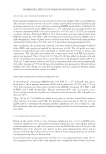MODULATION OF CELLULAR SENESCENCE 87 (4) E. Sikora, T. Arendt, M. Bennett, and M. Narita, The impact of cellular senescence signature on ageing research, Ageing Res. Rev., 37, 146–152 (2011). (5) A. W. Bahta, N. Farjo, B. Farjo, and M.P. Philpott, Premature senescence of balding dermal papilla cells in vitro is associated with p16(INK4a) expression, J. Invest. Dermatol., 128, 1088–1094 (2008). (6) F. Debacq-Chainiaux, C. Borlon, T. Pascal, V. Royer, F. Eliaers, N. Ninane, G. Carrard, B. Friguet, F. de Longueville, S. Boffe, J. Remacle, and O. Toussaint, Repeated exposure of human skin fi broblasts to UVB at subcytotoxic level triggers premature senescence through the TGF-β1 signaling pathway, J. Cell Sci., 118, 743–758 (2004). (7) J. Chen, S. Patschan, and M.S. Goligorsky, Stressed-induced premature senescence of endothelial cells, J. Nephrol., 21, 337–344 (2008). (8) D.J Baker, T. Wijshake, T. Tchkonia, N.K. LeBrasseur, B.G. Childs, B. van de Sluis, J.L. Kirkland, and J.M. van Deursen, Clearance of p16Ink4a-positive senescent cells delays ageing-associated disorders, Nature, 479, 232–236 (2011). (9) U. Herbig, W. A. Jobling, B. P. Chen, D. J. Chen, and J. M. Sedivy, Telomere shortening triggers senescence of human cells through a pathway involving ATM, p53, and p21(CIP1), but not p16(INK4a), Mol. Cell, 14, 501–513 (2004). (10) Y. Shiloh and M. B. Kastan, ATM: Genome stability, neuronal development, and cancer cross paths, Adv. Cancer Res., 83, 209–254 (2001). (11) H. Zhan, T. Suzuki, K. Aizawa, K. Miyagawa, and R. Nagai, Ataxia telangiectasia mutated (ATM)- mediated DNA damage response in oxidative stress-induced vascular endothelial cell senescence, J. Biol. Chem., 285, 29662–29670 (2010). (12) M.B. Kastan and D. S. Lim, The many substrates and functions of ATM, Nature Rev. Mol. Cell Biol., 1, 179–186 (2000). (13) G. P. Dimri, X. Lee, G. Basile, M. Acosta, G. Scott, C. Roskelley, E. E. Medrano, M. Linskens, I. Rubeli, O. Pereira-Smith, M. Peacocke, and J. Campisi, A biomarker that identifi es senescent human cells in culture and in aging skin in vivo, Proc. Natl. Acad. Sci., 92, 9363–9367 (1995). (14) D. J. Schlemm, M. J. Crowe, R. B. McNeill, A. E. Stanley, and S. J. Keller, Medicinal yeast extracts, Cell Stress Chaperones, 4, 171–176 (1999). (15) M. J Crowe, R. B. McNeill, D. J. Schlemm, D. G. Greenhalgh, and S. J. Keller, Topical application of yeast extract accelerates the wound healing of diabetic mice, J. Burn Care Rehabil., 20, 155–162(1999). (16) J. M. Liptak, An overview of the topical management of wounds, Aust. Vet., 75, 408–413 (1997). (17) S. J. Keller, R. H. Levin, and J. Fang, Isolation and characterization of a tissue respiratory factor from baker’s yeast, J. Cell Biol., 119, 1005–1008 (1991). (18) J. P. Bentley, T. K. Hunt, J. B. Weiss, C. M. Taylor, A. N. Hanson, G. H. Davies, and B. J. Halliday, Peptides from live yeast cell derivatives stimulate wound healing, Arch. Surg., 125, 641–646 (1990). (19) W. Goodson, D. Hohn, T. K. Hunt, and D. Y. K. Leung, Augmentation of some aspects of wound heal- ing by a skin respiratory factor, J. Surg. Res., 21, 125–129 (1976). (20) O. E. Sorensen, J. B. Cowland, K. Theilgaard-Monch, L. Liu, T. Ganz, and N. Borregaard, Wound heal- ing and expression of antimicrobial peptides/polypeptides in human keratinocytes, a consequence of common growth factors, J. Immunol., 170, 5583–5589 (2003). (21) S. O. Canapp, J. P. Farese, G. S. Schultz, S. Gowda, A. M. Ishak, S. F. Swaim, J. Vangilder, L. Lee- Ambrose, and F. G. Martin, The effect of topical tripeptide-copper complex on healing of ischemic open wounds, Vet. Surg., 32, 515–523 (2003). (22) V. Frei, E. Perrier, I. Orly, A. Huc, C. Augustin, and O. Damour, Activation of fi broblast metabolism in a dermal and skin equivalent model: A screening test for activity of peptides, Int. J. Cosmet. Sci., 20, 159–173 (1998). (23) K. Katayama, J. Armendariz-Borunda, R. Raghow, A. H. Kang, and J. M. Seyer, A pentapeptide from type I procollagen promotes extracellular matrix production, J. Biol. Chem., 268, 9941–9944 (1993). (24) M. P. Lupo and A. L. Cole, Cosmeceutical peptides, Dermatol. Ther., 20, 343–349 (2007). (25) Gruber JV and Holtz R, Examining the genomic infl uence of skin antioxidants in vitro, Mediators Infl amm., 2010, 1–10 (2010). (26) S. Zdanov, J. Remacle, and O. Toussaint, Establishment of H2O2-induced premature senescence in hu- man fi broblasts concomitant with increased cellular production of H2O2, Ann NY Acad Sci., 1067, 210–216 (2006). (27) D. J. Tobin, Ex vivo organ culture of human hair follicles: A model epithelial-neuroectodermal-mesenchymal interaction system, Methods Mol. Biol., 695, 213–227 (2011).
Purchased for the exclusive use of nofirst nolast (unknown) From: SCC Media Library & Resource Center (library.scconline.org)

















































































